Arvieux
Arvieux is a commune of the Hautes-Alpes department in the Provence-Alpes-Côte d'Azur region of south-eastern France.
Arvieux | |
|---|---|
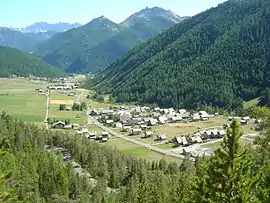 The valley between Brunissard and Arvieux | |
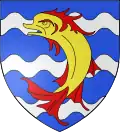 Coat of arms | |
Location of Arvieux 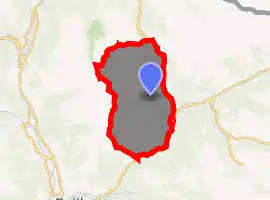
| |
 Arvieux 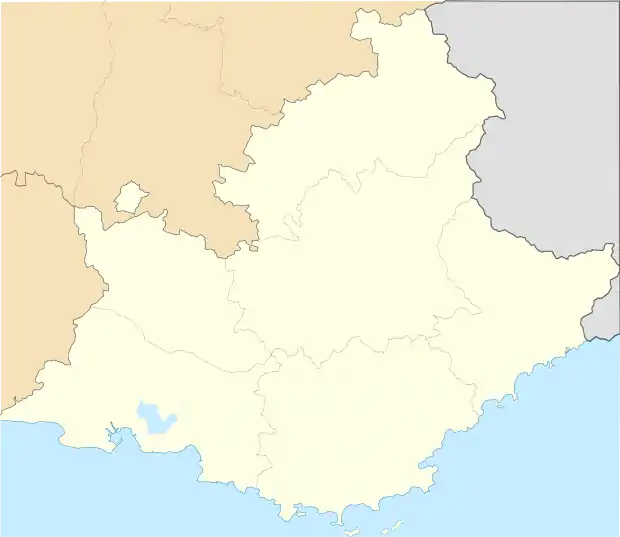 Arvieux | |
| Coordinates: 44°46′02″N 6°44′23″E | |
| Country | France |
| Region | Provence-Alpes-Côte d'Azur |
| Department | Hautes-Alpes |
| Arrondissement | Briançon |
| Canton | Guillestre |
| Intercommunality | Guillestrois et Queyras |
| Government | |
| • Mayor (2014-2020) | Philippe Chabrand[1] |
| Area 1 | 72.62 km2 (28.04 sq mi) |
| Population (2017-01-01)[2] | 365 |
| • Density | 5.0/km2 (13/sq mi) |
| Time zone | UTC+01:00 (CET) |
| • Summer (DST) | UTC+02:00 (CEST) |
| INSEE/Postal code | 05007 /05350 |
| Elevation | 1,138–2,905 m (3,734–9,531 ft) (avg. 1,545 m or 5,069 ft) |
| 1 French Land Register data, which excludes lakes, ponds, glaciers > 1 km2 (0.386 sq mi or 247 acres) and river estuaries. | |
The inhabitants of the commune are known as Arvidants or Arvidantes.[3]
Geography
Arvieux lies at the foot of the Col d'Izoard in the Arvieux Valley some 20 km south by south-east of Briançon and 13 km east by north-east of La Roche-de-Rame. It is surrounded by the high mountains of the Massif du Queyras whose highest point is in the commune at Pic du Béal Traversier at 2912 m. Access to the commune is by the D902 from Cervières in the north which goes by a tortuous route through the commune to the village then continues south-east to Guillestre. Apart from the village there are the hamlets of La Draye, Brunissard La Chalp, and Le Coin north of the village and La Cassiere, Les Maisons, Le Pasquier, Villargaudin, Les Moulins, Les Escoyeres, and Les Esponces south of the village. The commune is a high alpine commune with snow-covered mountains and rugged terrain.[4]
Details of some of the hamlets are:
- Les Escoyères, the first hamlet, is located at the end of a small winding road starting west of the Guil valley and is 1,532 m above sea level on a south-facing slope. The Chapel of St. Mary Magdalene, built in the 17th century, whose door lintels are made with a Roman stele (see History section) and two sundials by Giovanni Francesco Zarbula are there.
- Villargaudin or Villard-Gaudin is at 1593 m altitude on another road to the west at the bottom of the valley after the Queyron.
- Les Moulins (The Mills) is at 1410 m and was so named because there were once several mills here built to use the power of the Aigue d'Arvieux.
- Le Pasquier is located at 1570 m altitude at mid-slope on the eastern side.
Les Maisons is located at 1690 m a little higher on the same side of the valley.
- Arvieux village at 1550 m is in the centre of the valley. It is the capital of the commune. The St Lawrence Church dating from the 16th century and the Protestant church are located there. The village can be accessed on foot from Furfande.
- Le Coin is a small hamlet at 1600 m west of Arvieux.
- La Chalp is 2 km north of Arvieux and is the highest in the valley at 1680 m altitude. La Chalp is a common name in the Alps and means pastureland. There is a mountain resort here.
- Brunissard is the last village of the commune situated amidst meadows which rise to 1760 m altitude. The valley is separated into two with the north-west branch the path to the Col des Ayes, the alpine pastures of Clapeyto and the Col de Néal; the north-east branch leads to the Col d'Isoard (or Izoard).
The commune also has several hamlets consisting of alpine chalets. The most important are those of Furfande and Clapeyto.
The Guil forms the southern border as it flows south-west to join the Durance at Réotier. The Torrent de l'Izoard rises in the north of the commune and flows south through the centre fed by many tributaries, changing to the Torrent de la Rivière at Brunissard then back to the Torrent de l'Izoard at Le Coin, as it continues south to join the Guil. The Torrent de la Rabanelle rises in the west of the commune and flows east to join the Torrent de la Rivière at Brunissard.[4]
Neighbouring communes and villages
Toponymy
The name Arvieux comes from the Latin arviolum meaning "small field".
One of the oldest monuments of the village and the valley of the Izoard, Campanile Brunissard, is itself only a fascinating summary of the economic, cultural and social life in the Hautes-Alpes, especially in Queyras 1 .
History
Antiquity
The ancient history of Arvieux is not well known. Occupied since antiquity, Arvieux was the first valley which was reached when passing through the Col Néal which was probably the ancient access route to the upper Queyras. The second access road, probably dominant, linked directly to the Durance basin at Queyras via a Roman road that ran from the hamlet of Gros passing through Escoyères which was probably in Roman times a place of testing "taxes". Part of this pathway, under overhanging cliffs, is still visible today (the Chemin de Charve).
During antiquity the area was inhabited by Gallic people called Quariates by the Romans whose name is probably formed from a Celtic root meaning "those of the cauldron" and from which Queyras is derived. The name Quariates is attested on a Roman stone found in the Chapel of Sainte-Marie-Madeleine at Escoyères. On this truncated stone there is a Latin inscription which mentions a man named Albanus Bussulus who was prefect of Capillates, Savincates (probably people living in the Savines valley), Brigani (people from Briançon), and Quariates.
Middle Ages - the Escarton of Queyras
The region suffered several invasions after the end of the Roman Empire with many Saracen incursions. Some say that on this occasion Queyras was deserted but an eventual abandonment that left no trace remains unlikely.
The Dauphins of Vienne received the Briançonnais and therefore the Queyras in fief in 1050. Arvieux was then part of the Kingdom of Dauphiné. The Briançonnais were divided into five entities called Escartons of which Queyras was part. Each Escarton was composed of communities called "universities". Arvieux was then one of the seven universities of Queyras, the others being: Abriès, Aiguilles, Molines, Ristolas, Saint-Véran, and Vielle-Ville.
At the end of the Middle Ages the Dauphin Humbert II, while short of money, gave a little more independence to the Escartons in exchange for an annual rent. Arvieux became part of what was later called abusively the Republic of Escartons.
This feudal entity was specifically created by the Charter signed in 1343 between the Dauphin and the Briançon communities. The Escarton of Queyras was an administrative unit responsible for collecting taxes. The Escarton Communities obtained from the Dauphin the right to manage paying their taxes themselves.
The Arvieux community was one of the seven "Universities" in the Escarton of Queyras and the capital was located at Ville-Vieille. There were a total of five Escartons.
The charter gave the inhabitants of the escartons the status of "francs-bourgeois", that is to say they were exempt from feudal service in exchange for an annual rent. The people had the right to elect their representatives called "consuls". They also had the right to hunt. Justice however remained a privilege of the Dauphin and the inhabitants of the escartons had to participate in the defence of the Dauphiné.
In 1349, six years after the signing of the charter, the Dauphiné was ceded to France who perpetuated these rights until the French Revolution. Under the ancien regime Arvieux was thus a relatively wealthy town in the French Alps. The relative prosperity of the village community was achieved despite numerous calamities. The wars of religion did not spare Arvieux. In 1630 the plague came from Italy and ravaged the region. The town was burned in 1638.
Modern era - Catholics and Protestants
Protestantism arrived in Arvieux during the second half of the 16th century. Queyrassins adhered in large numbers to the Reformation. Disorders occurred in the valley. After the Edict of Nantes Arvieux had a Protestant church. After the Revocation of the Edict of Nantes many people emigrated. During the war against the Catholic League of Augsburg from 1690 to 1696 Arvieux is crossed by the troops of the King of France and had to provide wood, fodder, food, and animals for the army. Militiamen from Vaud crossed the border several times and burned villages. Around 1700 Arvieux and Queyras generally was weakened but the region regained its prosperity before the Revolution.
The Revolution abolished the status of Escartons and the university of Arvieux became a commune. The Edict of Tolerance (1787) and the Revolution agreed to new freedoms of worship for Protestants.
Recent history
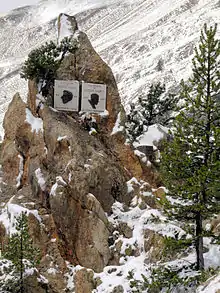
After the Revolution some of the inhabitants became officially Protestant and the inhabitants of Arvieux were divided between the two religious communities: the majority of Catholics were in the village of Arvieux and at the bottom of the valley while there were mainly Protestants in the present top of the valley at Brunissard and La Chalp which was the place of residence of their pastor.
Arvieux, as with all communes in Queyras suffered severe depopulation from 1830. First seasonally during the cold season, emigration became permanent in the middle of the 19th century. Having reached a maximum of 1,004 inhabitants in 1841, the population was reduced by two thirds in 150 years. The exodus, which stopped from that point, was to the cities (mainly Marseille). The difficult living conditions in the mountains as well as more specific calamities (Brunissard was completely destroyed by fire in 1882) explain this phenomenon. Nevertheless, to maintain perspective, Arvieux preserved its population more than any other in Queyras.
During the 20th century the economy was gradually transformed. Originally a fully agro-pastoral economy, it now relied mainly on tourism. This transition was nevertheless late in Arvieux and it was the commune in Queyras where agro-pastoral culture lasted the longest - up to about World War II.
By the relative weakness of emigration and by maintaining agro-pastoral activity for a relatively long time, Arvieux was a somewhat atypical commune in Queyras. This originality is probably related to the relative mild weather in the Arvieux Valley for agriculture compared to other communes in Queyras.
The use of French among the inhabitants is relatively recent in Arvieux as they spoke a dialect in the early 20th century. Literacy, however, was relatively advanced due to the Protestant culture of part of the population.
The opening of the Col d'Izoard in 1934 made the commune one of the highlights of the Tour de France. The pass is closed in winter.
In 1977 the Regional Natural Park of Queyras was established with Arvieux being one of the communes it covers.
The Belle and the Renon
Life in Arvieux was different for historians because of a unique organization. Arvieux society was historically divided into two castes:
1. The Gens du Renom or Race des Sorciers who were the lower caste people 2. The Gens de la Belle who formed a kind of local aristocracy
This distinction (which was not related to Protestants and Catholics) lasted until the town opened to the outside in the second half of the 20th century. Its origin is uncertain but it did not prevent solidarity among villagers. In Arvieux first place was reserved for widows and orphans.
Heraldry
 Arms of Arvieux |
These arms were adopted by the town council on 10 August 1968: the Mayor at that time was Louis Blanc-Chabrand
Blazon: |
Administration
List of Successive Mayors[5]
| From | To | Name | |
|---|---|---|---|
| 1790 | 1891 | Jacques Borel | |
| 1791 | 1792 | Jacques Meissimilly | |
| 1792 | 1795 | Laurent Albert | |
| 1795 | 1800 | Jacques Laurent Eymar | |
| 1800 | 1805 | Jacques Albert | |
| 1805 | 1809 | Jacques Eymar | |
| 1809 | 1813 | Jean Antoine Eymar | |
| 1813 | 1818 | Jean Meissimilly | |
| 1818 | 1832 | Claude Meissimilly | |
| 1832 | 1835 | Jean Antoine Meissimilly | |
| 1835 | 1838 | Jacques Simond | |
| 1838 | 1840 | Claude Eymar | |
| 1840 | 1848 | Claude Meissimilly | |
| 1848 | 1852 | André Albert | |
| 1852 | 1860 | Jean Eymar | |
| 1860 | 1871 | Jean Garcin | |
| 1871 | 1892 | Jean Désiré Blanc | |
| 1892 | 1896 | Charles Nicolas Meissimily | |
| 1896 | 1902 | Jean Laurent Albert | |
| 1902 | 1904 | Charles Nicolas Meissimily | |
| 1904 | 1914 | Jacques Philip | |
| 1914 | 1917 | Antoine Eymar | |
| 1917 | 1929 | Jacques Philip | |
| 1929 | 1937 | Charles Simond | |
| 1937 | 1940 | Jean-Baptiste Eymar |
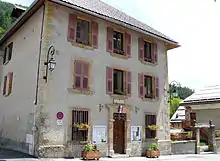
- Mayors from 1940
| From | To | Name | Party | Position |
|---|---|---|---|---|
| 1940 | 1945 | Pierre Borel | ||
| 1945 | 1947 | Pierre Albert | ||
| 1947 | 1959 | Laurent Nicolas Meissimily | ||
| 1959 | 1977 | Louis Blanc Chabrand | ||
| 1977 | 1995 | Pierre Blanc | ||
| 1995 | 2001 | Alain Blanc | ||
| 2001 | 2008 | Pierre Blanc | ||
| 2008 | 2014 | Alain Blanc | DVG | |
| 2014 | Current | Philippe Chabrand | LR |
(Not all data is known)
Population
| Year | Pop. | ±% |
|---|---|---|
| 2005 | 347 | — |
| 2006 | 348 | +0.3% |
| 2007 | 353 | +1.4% |
| 2008 | 360 | +2.0% |
| 2009 | 368 | +2.2% |
| 2010 | 375 | +1.9% |
| 2011 | 373 | −0.5% |
| 2012 | 371 | −0.5% |
| 2013 | 368 | −0.8% |
| 2014 | 366 | −0.5% |
| 2015 | 363 | −0.8% |
| 2016 | 372 | +2.5% |
Politics
Presidential Elections 2nd Round
| Election | Winning Candidate | Party | % | |
|---|---|---|---|---|
| 2017 | Emmanuel Macron | EM | 73.44 | |
| 2012 | Nicolas Sarkozy | UMP | 55.16 | |
| 2007 | Nicolas Sarkozy | UMP | 57.65 | |
| 2002 | Jacques Chirac | RPR | 84.12 | |
Economy
Arvieux has a tourism economy both in winter and summer. In winter there is alpine skiing, cross country skiing, and ski touring. Summer is the season for hiking. Crafts (pottery, manufacture of wooden toys of Queyras, carved furniture) and livestock (for cheese making) also have an important role.
Culture and heritage
Civil heritage
The commune has many buildings and structures that are registered as historical monuments:
- The Fantin House (1731)
 [7]
[7] - The Route over the Col de l'Izoard (1710)
 [8]
[8] - A Bakery at Villargaudin (18th century)
 [9]
[9] - Le Veyer (13th century)
 [10]
[10] - A Flour Mill (1803)
 [11]
[11] - Furfande
 [12]
[12] - A Fountain Boundary Stone (1865)
 [13]
[13] - A Bakery at Les Escoyeres (18th century)
 [14]
[14] - The Cooperative Cheese Factory at Les Escoyeres (1927)
 [15]
[15] - A Bakery at Brunissard (18th century)
 [16]
[16] - The Town Hall (19th century)
 [17]
[17] - Arvieux Town
 [18]
[18]
In addition the commune has a very large number of Farmhouses that are registered as historical monuments.[19]
- Other sites of interest
- The Bell Tower at Brunissard
- Many interesting Sundials. Two are located at Escoyėres and signed Zarbula: one from 1842 (Baroque) and one at Saint-Roch dated 1857 (period of birds).
 The Col d'Izoard route
The Col d'Izoard route The Col d'Izoard route
The Col d'Izoard route The Col d'Izoard in winter
The Col d'Izoard in winter Brunissard
Brunissard A Farmhouse in the town
A Farmhouse in the town A fountain in the town
A fountain in the town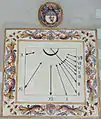 The Queyras sundial
The Queyras sundial A sundial at Arvieux
A sundial at Arvieux
Religious heritage
The commune has many religious buildings and structures that are registered as historical monuments:
- The Benedictine Chapel of Sainte-Marie-Madeleine (1700)
 [20][21] The church contains several items that are registered as historical objects:
[20][21] The church contains several items that are registered as historical objects:
- The Church (16th century)
 [26]
[26] - The Chapel of Saint-Jacques le Majeur at Villargaudin (18th century).
 [27] The church contains several items that are registered as historical objects:
[27] The church contains several items that are registered as historical objects:
- The Parish Church of Saint-Claude at Le Veyer (15th century)
 [33] The church contains many items that are registered as historical objects:
[33] The church contains many items that are registered as historical objects:
- A Painting: Annunciation (19th century)
 [34]
[34] - A Painting with frame: Apparition of the Virgin and child to Saint Antoine (17th century)
 [35]
[35] - A Painting: Apparition of the Virgin and child to Saint Antoine (19th century)
 [36]
[36] - A Painting: Saint Claude de Besançon (17th century)
 [37]
[37] - 2 Busts-Reliquaries: Saints (18th century)
 [38]
[38] - A Celebrant's Chair (1675)
 [39]
[39] - A Sacristy Cabinet (1) (19th century)
 [40]
[40] - A Sacristy Cabinet (2) (19th century)
 [41]
[41] - An Altar Pulpit (1828)
 [42]
[42] - A Stoup (1865)
 [43]
[43] - The Furniture in the Church
 [44]
[44]
- A Painting: Annunciation (19th century)
- The Chapel of Saint-Romuald near Serre (1785)
 [45]
[45] - The Chapel of Saint-Roche at Les Escoyeres (1720)
 [46] The church contains a large number of items that are registered as historical objects.[46]
[46] The church contains a large number of items that are registered as historical objects.[46] - The Chapel of Saint-Marcellin at Le Chatelard (1793).
 [47] The chapel contains several items that are registered as historical objects:
[47] The chapel contains several items that are registered as historical objects:
- A Host Box (1727)
 [48]
[48] - A Statuette: Virgin and child (18th century)
 [49]
[49] - A Statuette: Immaculate Conception (19th century)
 [50]
[50] - A Painting with frame: Saint Pape Martyr (18th century)
 [51]
[51] - A Painting with frame: Saint Pape Martyr (18th century)
 [51]
[51] - 2 rows of seats (18th century)
 [52]
[52] - A Cabinet (18th century)
 [53]
[53] - The Furniture in the Chapel
 [54]
[54]
- A Host Box (1727)
- The Chapel Evangelique at Brunissard (19th century).
 [55] The chapel contains one item that is registered as an historical object:
[55] The chapel contains one item that is registered as an historical object:
- The Chapel of Saint-Pierre at Brunissard (1845)
 [57] The chapel contains two items that are registered as historical objects:
[57] The chapel contains two items that are registered as historical objects:
- The Protestant Church (1887)
 [60]
[60] - The Parish Church of Saint-Laurent (15th century)
 [61] The church contains a very large number of items that are registered as historical objects.[61]
[61] The church contains a very large number of items that are registered as historical objects.[61]
 Church of Saint-Laurent.
Church of Saint-Laurent. The Church Door
The Church Door The Nave of the Church.
The Nave of the Church. The vault of the choir.
The vault of the choir. Remains of a mural in the porch
Remains of a mural in the porch The Cemetery
The Cemetery The Arvieux Protestant Church.
The Arvieux Protestant Church.
Notable people linked to the commune
- Albanus, prefect of the western Alps in the 1st century
See also
External links
- Queyras: History, Culture, Heritage (in French)
- Arvieux on the old IGN website (in French)
- Arvieux on Lion1906
- Arvieux on Géoportail, National Geographic Institute (IGN) website (in French)
- Auvien on the 1750 Cassini Map
Notes and references
Notes
References
- "List of mayors of the Hautes-Alpes department". Prefecture of Hautes-Alpes (in French). 3 June 2014. Archived from the original on 10 January 2015. Retrieved 20 March 2015.
- "Populations légales 2017". INSEE. Retrieved 6 January 2020.
- Inhabitants of Hautes-Alpes (in French)
- Google Maps
- List of Mayors of France (in French)
- http://www.lemonde.fr/data/france/presidentielle-2017/
- Ministry of Culture, Mérimée IA00124804 Fantin House (in French)

- Ministry of Culture, Mérimée IA00124855 Route over the Col de l'Izoard (in French)

- Ministry of Culture, Mérimée IA00124853 Bakery at Villargaudin (in French)

- Ministry of Culture, Mérimée IA00124846 Le Veyer (in French)
- Ministry of Culture, Mérimée IA00124841 Flour Mill (in French)

- Ministry of Culture, Mérimée IA00124831 Furfande (in French)
- Ministry of Culture, Mérimée IA00124828 Fountain Boundary Stone (in French)

- Ministry of Culture, Mérimée IA00124827 Bakery at Les Escoyeres (in French)

- Ministry of Culture, Mérimée IA00124824 Cooperative Cheese Factory at Les Escoyeres (in French)

- Ministry of Culture, Mérimée IA00124817 Bakery at Brunissard (in French)

- Ministry of Culture, Mérimée IA00124812 Town Hall (in French)

- Ministry of Culture, Mérimée IA00124809 Arvieux Village (in French)
- Base Mérimée: Search for heritage in the commune, Ministère français de la Culture. (in French)
- Ministry of Culture, Mérimée IA00124854 Benedictine Chapel of Sainte-Marie-Madeleine (in French)

- Ministry of Culture, Mérimée PA00080520 Chapel of Sainte-Marie-Madeleine (in French)

- Ministry of Culture, Palissy PM05000006 2 Hanging Cabinets (in French)
- Ministry of Culture, Palissy IM05000807 Reliquary (in French)
- Ministry of Culture, Palissy IM05000806 2 Statues: Angels (in French)

- Ministry of Culture, Palissy IM05000805 Furniture in the Chapel of Sainte-Marie-Madeleine (in French)

- Ministry of Culture, Mérimée PA00080521 Church (in French)

- Ministry of Culture, Mérimée IA00124848 Chapel of Saint-Jacques le Majeur (in French)
- Ministry of Culture, Palissy IM05000841 2 Hanging Cabinets (in French)
- Ministry of Culture, Palissy IM05000840 Painting: Saint Jacques le Majeur (in French)

- Ministry of Culture, Palissy IM05000839 Retable (in French)
- Ministry of Culture, Palissy IM05000838 Altar (in French)
- Ministry of Culture, Palissy IM05000836 Furniture in the Chapel of Saint-Jacques le Majeur (in French)
- Ministry of Culture, Mérimée IA00124847 Parish Church of Saint-Claude (in French)

- Ministry of Culture, Palissy IM05000835 Painting: Annunciation (in French)
- Ministry of Culture, Palissy IM05000834 Painting with frame: Apparition of the Virgin and child to Saint Antoine (in French)
- Ministry of Culture, Palissy IM05000833 Painting: Apparition of the Virgin and child to Saint Antoine (in French)
- Ministry of Culture, Palissy IM05000832 Painting: Saint Claude de Besancon (in French)
- Ministry of Culture, Palissy IM05000831 2 Busts-Reliquaries: Saints (in French)
- Ministry of Culture, Palissy IM05000830 Celebrant's Chair (in French)

- Ministry of Culture, Palissy IM05000828 Sacristy Cabinet (1) (in French)

- Ministry of Culture, Palissy IM05000829 Sacristy Cabinet (2) (in French)

- Ministry of Culture, Palissy IM05000827 Altar Pulpit (in French)
- Ministry of Culture, Palissy IM05000826 Stoup (in French)

- Ministry of Culture, Palissy IM05000825 Furniture in the Church of Saint-Claude (in French)

- Ministry of Culture, Mérimée IA00124845 Chapel of Saint-Romuald (in French)
- Ministry of Culture, Mérimée IA00124825 Chapel of Saint-Roche at Les Escoyeres (in French)

- Ministry of Culture, Mérimée IA00124819 Chapel of Saint-Marcellin at Le Chatelard (in French)

- Ministry of Culture, Palissy IM05000804 Host Box (in French)

- Ministry of Culture, Palissy IM05000803 Statuette: Virgin and child (in French)

- Ministry of Culture, Palissy IM05000802 Statuette: Immaculate Conception (in French)

- Ministry of Culture, Palissy IM05000801 Painting with frame: Saint Pape Martyr (in French)
- Ministry of Culture, Palissy IM05000800 2 rows of seats (in French)
- Ministry of Culture, Palissy IM05000799 Cabinet (in French)

- Ministry of Culture, Palissy IM05000798 Funiture in the Chapel of Saint-Marcellin (in French)
- Ministry of Culture, Mérimée IA00124814 Chapel Evangelique at Brunissard (in French)

- Ministry of Culture, Palissy IM05000797 Pastoral Pulpit (in French)

- Ministry of Culture, Mérimée IA00124813 Chapel of Saint-Pierre at Brunissard (in French)
- Ministry of Culture, Palissy IM03000795 Painting: Miraculous Rescue (in French)
- Ministry of Culture, Palissy IM05000796 Furniture in the Chapel of Saint-Pierre (in French)
- Ministry of Culture, Mérimée IA00124811 Protestant Church (in French)

- Ministry of Culture, Mérimée IA00124810 Parish Church of Saint-Laurent (in French)

| Wikimedia Commons has media related to Arvieux. |